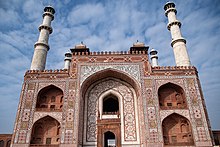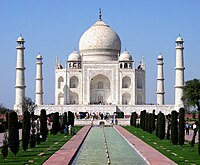Akbar's tomb
| Tomb of Akbar | |
|---|---|
 Akbar's tomb of external entrance from the road, built to imitate the Buland Darwaza at Fatehpur Sikri, the city Akbar founded | |
| Religion | |
| Affiliation | Islam |
| District | Sikandra |
| Province | Agra |
| Ecclesiastical or organizational status | Tomb |
| Leadership | Jahangir |
| Year consecrated | 1605 |
| Location | |
| Location | |
| Territory | Sikandra |
| Geographic coordinates | 27°13′14″N 77°57′01″E / 27.22044°N 77.95031°E |
| Architecture | |
| Type | Tomb |
| Style | Mughal architecture |
| Completed | In 1613 |
| Specifications | |
| Direction of façade | Four-tiered pyramid |
| Height (max) | 100 ft |
| Materials | Red Sandstone White Marble |
Akbar's tomb is the mausoleum of the third and greatest Mughal emperor Akbar. The tomb was built in 1605–1613 by his son, Jahangir and is situated on 119 acres of grounds in Sikandra, a suburb of Agra, Uttar Pradesh, India. The buildings are constructed mainly from a deep red sandstone, enriched with features in white marble.[1][2]
Location
[edit]It is located at Sikandra, in the suburbs of Agra, on the Mathura road (NH2), 8 km west-northwest of the city center. About 1 km away from the tomb, lies, Tomb of Mariam-uz-Zamani, his favourite wife,[3] who after the death of Akbar laid a large garden around his tomb and was later buried there by her son, Jahangir.[4]
History
[edit]
Akbar I was the third Mughal emperor, who reigned from 1556 to 1605. Akbar succeeded his father, Humayun, under a regent, Bairam Khan, who helped the young emperor expand and consolidate Mughal domains in the Indian subcontinent.[5][6] Akbar gradually enlarged the Mughal Empire to include much of the Indian subcontinent through Mughal military, political, cultural, and economic dominance. Under Akbar, Mughal India developed a strong and stable economy, which tripled in size and wealth, leading to commercial expansion and greater patronage of an Indo-Persian culture.[7][8] Akbar's courts at Delhi, Agra, and Fatehpur Sikri attracted holy men of many faiths, poets, architects, and artisans, and become known as centres of the arts, letters, and learning.[9]
On 3 October 1605, Akbar fell ill from an attack of dysentery, from which he never recovered. He is believed to have died on 26 October 1605.[10][11] After Akbar's death, his son Jahangir planned and completed the construction of his father's tomb in 1605–1613. It cost 1,500,000 rupees to build and took 3 or 4 years to complete.[12][13]

As Viceroy of India, George Curzon directed extensive repairs and restoration of Akbar's mausoleum, which were completed in 1905. Curzon discussed the restoration of the mausoleum and other historical buildings in Agra in connection with the passage of the Ancient Monuments Preservation Act in 1904, when he described the project as "an offering of reverence to the past and a gift of recovered beauty to the future". This preservation project may have discouraged veneration of the mausoleum by pilgrims and people living nearby.[14]
Architecture and ornamentation
[edit]
The south gate is the largest, with four white marble chhatri-topped minarets, which are similar to (and pre-date) those of the Taj Mahal, and is the normal point of entry to the tomb. The tomb itself is surrounded by a walled enclosure 105 m square. The tomb building is a four-tiered pyramid, surmounted by a marble pavilion containing the false tomb. The true tomb, as in other mausoleums, is in the basement.[15]
The buildings are constructed mainly from a deep red sandstone, enriched with features in white marble. Decorated inlaid panels of these materials and a black slate adorn the tomb and the main gatehouse. Panel designs are geometric, floral and calligraphic, and prefigure the more complex and subtle designs later incorporated in Itmad-ud-Daulah's tomb.[16] There are four gateways in the tomb, which were built using red sandstone and design were inlaid using marble. The roof of the gateway has four kiosks. The magnificence of the gateway is inspired by the Buland Darwaza.[17]

Mariam-uz-Zamani, after the death of her husband, Akbar, laid a large garden around his tomb, which originally had an open baradari (pleasure pavilion) built during the reign of Sikander Lodi, in 1495 AD.[4] After her death in May 1623, she was buried here near her husband's tomb and the baradari was converted into a fine mausoleum by her son, Jahangir.[18] She stands as the only wife of Akbar buried closed to him.[19]
The first floor of the tomb, has cloisters on four sides having arches, and has a hall where the tombstone of Akbar lies. The hall also consist tombstones of Shakr-un-Nissa Begum and Aram Banu Begum, the two daughters of Akbar.[20][21]
Desecration of the tomb
[edit]On 28 March 1688, during the reign of Aurangzeb, Jats rose in rebellion under the leadership of Raja Ram Jat. Mughal prestige suffered a blow when Jats ransacked Akbar's tomb, plundering and looting the gold, jewels, silver, and carpets.[22] The grave was opened and the late king's bones were burned.[23][24] This successful raid followed a previous unsuccessful attempt in 1685 and resulted in an escalation of the conflict between the Mughals and the Jats.[25][26]
Gallery
[edit]-
An unknown Lodi tomb in Akbar's tomb complex
-
Barrel vault
-
Front façade
-
Circumferential gallery around the cenotaph
-
View of South Gate from interior
-
The Tomb of Akbar, c. 1905
-
Main entrance of Akbar's tomb complex from inside
-
Tomb ceiling details, Tomb of Akbar, Sikandra
-
Inlay panels on the South Gate
-
Calligraphy over the entrance to the main burial chamber
-
True Tomb of Akbar, at the basement of the tomb
-
Kanch Mahal, built by Jehangir, as a harem quarter later used as a hunting lodge
-
Inside work of Akbar's tomb
-
Entrance Arch (inside details) of main Cenotaph
-
Akbar's tomb at basement
-
The Tomb of Akbar at Secundra near Agra
See also
[edit]- Akbar
- Akbarnama
- Tomb of Mariam-uz-Zamani, tomb of the chief queen consort of Akbar
References
[edit]- ^ Smith, Vincent Arthur (1917). Akbar the Great Mogul. Oxford, Clarendon Press. p. 58. ISBN 0895634716. Archived from the original on 6 August 2017. Retrieved 13 November 2019.
- ^ Eraly, Abraham (2000). Emperors of the Peacock Throne, The Saga of the Great Mughals. Penguin Books India. p. 136. ISBN 0141001437.
- ^ Hindu Shah, Muhammad Qasim (1595–1612). Gulshan-I-Ibrahimi. Vol. 2. p. 143.
Akbur, after this conquest, made a pilgrimage to Khwaja Moyin-ood-Deen Chishty at Ajmere and returned to Agra; from whence he proceeded to visit the venerable Sheikh Sulim Chishty, in the village of Seekry. As all the king's children had hitherto died, he solicited the Sheikh's prayers, who consoled him, by assuring him he would soon have a son, who would live to a good old age. Shortly after, his favourite sooltana, being then pregnant, on Wednesday the 17th of Rubbee-ool-Awul, in the year 997 was delivered of a son, who was called Sulim.
- ^ a b Aziz, Al (12 August 1905). Selections from the Native Newspapers Published in the United Provinces of Agra & Oudh. p. 262. JSTOR saoa.crl.25922623.
- ^ Chandra, Satish (2005). Medieval India: from Sultanate to the Mughals (Revised ed.). New Delhi: Har-Anand Publications. pp. 111–112. ISBN 978-81-241-1066-9.
- ^ Srivastava. A.l. (1957). A Short History Of The Akbar The Great. p. 22.
- ^ Vogel, Dr. J. Ph. (1910). Annual Report Archaeological Survey Of India 1910-II. Superintendent Government Printing, Calcutta, India. p. 94.
- ^ Smith, Edmund W. (1973). Mughal Architecture of Fatehpur Sikri. Vol. I. Delhi: Indological Book. p. 31.
- ^ Lal, Muni (1980). Akbar.
- ^ "Remembering Akbar the Great: Facts about the most liberal Mughal emperor". India Today.
- ^ The Fatehpur Sikri Chronicles
- ^ "The Tuzuk-i-Jahangiri; or, Memoirs of Jahangir. Translated by Alexander Rogers. Edited by Henry Beveridge".
- ^ Havell, E. B. (Ernest Binfield) (1918). The history of Aryan rule in India from the earliest times to the death of Akbar. The Library of Congress. New York, Frederick A. Stokes company. p. 463.
- ^ Rajagopalan, Mrinalini (Summer 2011). "From loot to trophy: the vexed history of architectural heritage in imperial India" (PDF). International Institute for Asian Studies. Retrieved 3 January 2019.
- ^ "Fascinating monuments, timeless tales". The Hindu. Chennai, India. 22 September 2003. Archived from the original on 29 October 2003.
- ^ Akbar's Tomb Archived 2010-06-19 at the Wayback Machine Archnet.org.
- ^ Akbar's Tomb Architecture of Mughal India, Part 1, Volume 4, by Catherine Ella Blanshard Asher. Cambridge University Press, 1992. ISBN 0-521-26728-5. p. 107.
- ^ Mehta, J.L. (1981). Advance Study in the history of Medieval India. Vol. III. Sterling Publisher Private Limited. ISBN 8120704320.
Bihari Mal gave rich dowry to his daughter and sent his son Bhagwan Das with a contingent of Rajput soldiers to escort his newly married sister to Agra as per Hindu custom. Akbar was deeply impressed by the highly dignified, sincere and princely conduct of his Rajput relations. He took Man Singh, the youthful son of Bhagwant Das into the royal service. Akbar was fascinated by the charm and accomplishments of his Rajput wife; he developed real love for her and raised her to the status of chief queen. She came to exercise a profound impact on the socio-cultural environment of the entire royal household and changed the lifestyle of Akbar. Salim (later Jahangir), the heir to the throne, was born of this wedlock on 30th August 1569.
- ^ "Mariam's Tomb, Sikandara, Agra - Ticketed Monument - Archaeological Survey of India". Asi.nic.in. Archived from the original on 16 September 2013. Retrieved 8 December 2013.
- ^ Kanbo, Muhammad Saleh. Amal e Saleh al-Mausoom Ba Shahjahan Nama (Persian) - Volume 3. p. 117.
- ^ Fazl, Abul. The Akbarnama. Vol. III. Translated by Beveridge, Henry. Calcutta: ASIATIC SOCIETY OF BENGAL. p. 661.
One of the occurrences was the birth of Ārām Bānū Begam.* On 12 Dai, 22 December 1584, divine month, and the 19th degree of Sagittarius, and according to the calculation of the Indians, one degree and 54 minutes, that night-gleaming jewel of fortune appeared, and glorified the harem of the Shāhinshāh.
- ^ Catherine Blanshard Asher, Catherine Ella Blanshard Asher, 1992, "Architecture of Mughal India - Part 1", Cambridge University Press, Volume 4, Page 108.
- ^ Edward James Rap; son, Sir Wolseley Haig and Sir Richard, 1937, "The Cambridge History of India", Cambridge University Press, Volume 4, pp.305.
- ^ Waldemar Hansen, 1986, "The Peacock Throne: The Drama of Mogul India", Page 454.
- ^ Manucci, Niccolao (2010). Mogul India (1653–1708): Or Storia Do Mogor. Low Price Publication.
- ^ Dwivedi, Girish Chandra (1989). The Jats: Their Role in the Mughal Empire. Arnold Publishers. p. 36. ISBN 978-81-7031-150-8.
Further reading
[edit]- Keene, Henry George (1899). "Sikandra". A Handbook for Visitors to Agra and Its Neighbourhood (6 ed.). Thacker, Spink & Co. p. 43.
- Havell, Ernest Binfield (1904). "Sikandra". A Handbook to Agra and the Taj, Sikandra, Fatehpur-Sikri, and the Neighbourhood. Longmans, Green & Co., London.
External links
[edit]![]() Media related to Akbar's Tomb at Wikimedia Commons
Media related to Akbar's Tomb at Wikimedia Commons
- ASI's page on Akbar's tomb
- A painting of the tomb by William Purser, engraved by J Rolph, as an illustration to
 The Zenana., a poem by Letitia Elizabeth Landon.
The Zenana., a poem by Letitia Elizabeth Landon.

















